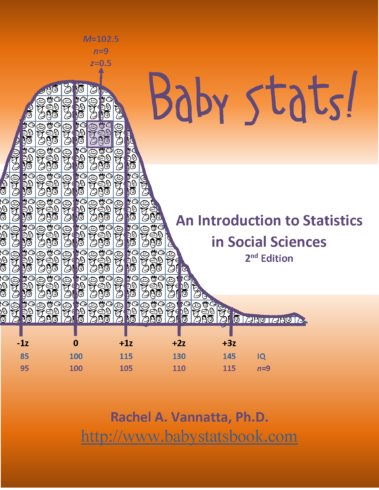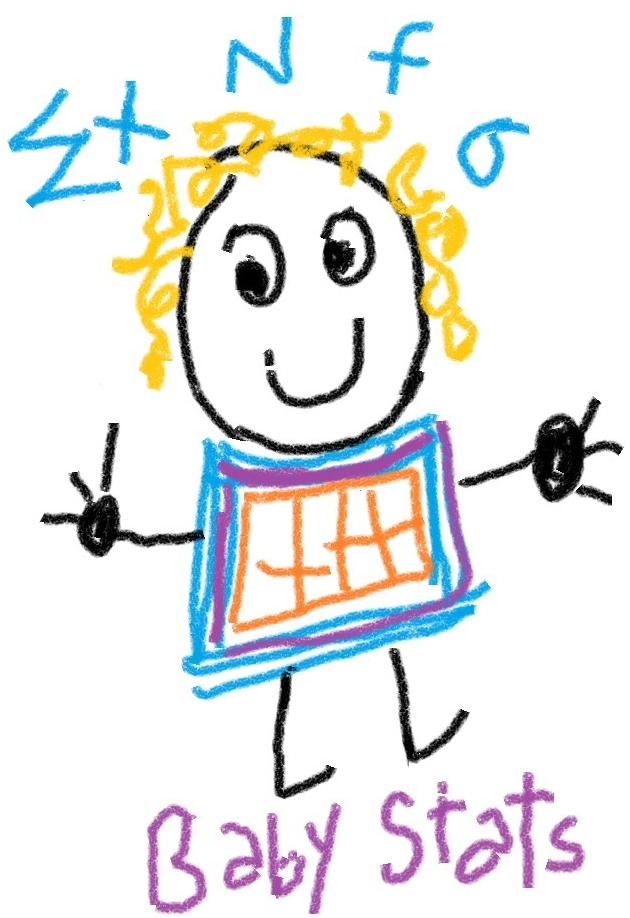
Overview

Specifically designed for an online or hybrid learning environment. Baby Stats! provides three distinct resources to support student learning.
- The Concepts is text-based and comparable to a traditional textbook but focuses on key concepts to keep the length down to 6-7 pages.
- The Learning Guide is a workbook that corresponds to the notes and activities presented in the module videos. The Learning Guide presents: notes for the video lecture; examples; activities; step-by-step instruction for using SPSS and StatCrunch; and exercises that facilitate conceptual understanding, interpretation of output and literature results, and application of analysis.
- The Videos simulate face-to-face classes in which content is presented by the author but also facilitates interaction with the content through reinforcing activities, practice problems. Videos typically run 30-45 minutes in length and are available for free.
Target Audiences and Content

Baby Stats! is designed to address the content of a typical course in Introductory Applied Statistics in Social Sciences. Undergraduate courses may include introductory statistics in psychology and sociology. Graduate courses may include introductory statistics in education, communications, and business. Materials are designed to support online and/or blended learning. Content is presented across thirteen modules and focus on hypothesis testing but also emphasize effect size, confidence intervals, and power.
Module 1—Introductory Concept
Module 2—Descriptive Statistics: Counting
Module 3—Descriptive Statistics: Measures
Module 4—Probability and z-scores
Module 5—Distribution of Sample Means
Module 6—Hypothesis Testing
Module 7—The t Statistic
Module 8—t-Test of Independent Samples
Module 9—t-Test of Related Samples
Module 10—ANOVA: Analysis of Variance
Module 11—Correlation & Regression
Module 12—Chi-Square
Module 13—All Together Now!
Appendices
A. The z Distribution
B. Power Table for z-Test
C. The t Distribution
D1. Power: t Single and t Related
D2. Power: t independent
E. The F Distribution
F. Pearson Correlation
G. Chi-Square
H. Baby Stats! Answer Key
About the Author

Dr. Rachel A. Vannatta is a Professor at Bowling Green State University (Ohio). In her 23 years of teaching in higher education, she has focused on creating more accessible and relatable statistics content. Since 2004, she has been teaching statistics in an online environment with videos and course packets. Baby Stats! is the product of fourteen years of experimenting with various instructional methods to better engage students in the learning process. Although she is a self-proclaimed numbers geek, numbers and statistics didn’t always come easy. As a result, she is always thinking of ways in which she can improve her instruction to guide student understanding.
Why the name Baby Stats! ?

Having taught both introductory and advanced statistics courses for twenty years, I noticed that my doctoral students always referred to the prerequisite introductory course as “Baby Stats!” After adopting this title, I decided to utilize my children’s art work to support the theme. All artwork was created by my children with the exception of the F-bomb of course!
SPSS and StatCrunch

Baby Stats! utilizes two statistical software packages. Guides on interpreting output and conducting the analyses are presented.
- SPSS is the most common statistical software in social sciences. It is available on most campuses or may be purchased as a student pack for about $100. however it may not be easily accessible if students are off-campus. As a result, a more accessible and inexpensive option is provided through StatCrunch. SPSS student pack is typically available for $100.
- StatCrunch is available through a subscription ($13 for 6 months) and is ideal option for off-campus students whose programs do not require SPSS.